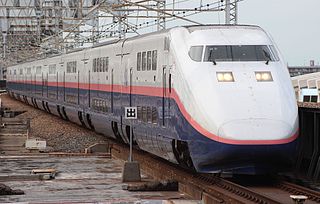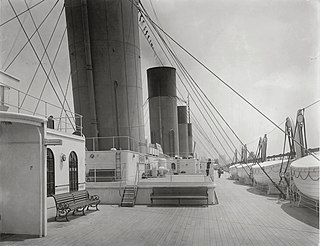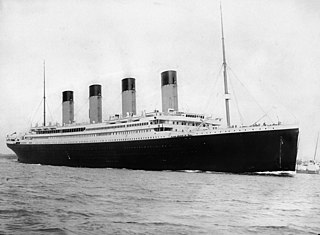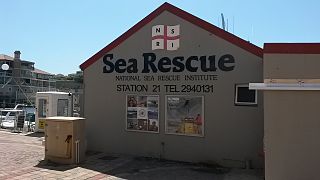This article needs additional citations for verification .(November 2012) |
A deckhead is the underside of a deck in a ship. It bears the same relationship to a compartment on the deck below as does the ceiling to the room of a house. [1]
This article needs additional citations for verification .(November 2012) |
A deckhead is the underside of a deck in a ship. It bears the same relationship to a compartment on the deck below as does the ceiling to the room of a house. [1]

An aircraft carrier is a warship that serves as a seagoing airbase, equipped with a full-length flight deck and facilities for carrying, arming, deploying, and recovering aircraft. Typically, it is the capital ship of a fleet, as it allows a naval force to project air power worldwide without depending on local bases for staging aircraft operations. Carriers have evolved since their inception in the early twentieth century from wooden vessels used to deploy balloons to nuclear-powered warships that carry numerous fighters, strike aircraft, helicopters, and other types of aircraft. While heavier aircraft such as fixed-wing gunships and bombers have been launched from aircraft carriers, these aircraft have not successfully landed on a carrier. By its diplomatic and tactical power, its mobility, its autonomy and the variety of its means, the aircraft carrier is often the centerpiece of modern combat fleets. Tactically or even strategically, it replaced the battleship in the role of flagship of a fleet. One of its great advantages is that, by sailing in international waters, it does not interfere with any territorial sovereignty and thus obviates the need for overflight authorizations from third-party countries, reduces the times and transit distances of aircraft and therefore significantly increase the time of availability on the combat zone.

The tarot is a pack of playing cards, used from at least the mid-15th century in various parts of Europe to play card games such as Italian Tarocchini. From their Italian roots, tarot playing cards spread to most of Europe evolving into a family of games that includes German Grosstarok and more recent games such as French Tarot and Austrian Königrufen which are still played today. In the late 18th century, French occultists began to make elaborate, but unsubstantiated, claims about their history and meaning, leading to the emergence of custom decks for use in divination via tarot card reading and cartomancy. Thus there are two distinct types of tarot pack: those used for playing games and those used for divination. However, some older patterns, such as the Tarot de Marseille, originally intended for playing card games, have also been used for cartomancy.

A cable-stayed bridge has one or more towers, from which cables support the bridge deck. A distinctive feature are the cables or stays, which run directly from the tower to the deck, normally forming a fan-like pattern or a series of parallel lines. This is in contrast to the modern suspension bridge, where the cables supporting the deck are suspended vertically from the main cable, anchored at both ends of the bridge and running between the towers. The cable-stayed bridge is optimal for spans longer than cantilever bridges and shorter than suspension bridges. This is the range within which cantilever bridges would rapidly grow heavier, and suspension bridge cabling would be more costly.

Jason Richard Hunter, better known by his stage name Inspectah Deck, is an American rapper, producer, and actor. He is a member of the groups Wu-Tang Clan and Czarface.

An amphibious transport dock, also called a landing platform/dock (LPD), is an amphibious warfare ship, a warship that embarks, transports, and lands elements of a landing force for expeditionary warfare missions. Several navies currently operate this kind of ship. The ships are generally designed to transport troops into a war zone by sea, primarily using landing craft, although invariably they also have the capability to operate transport helicopters.

The E1 series (E1系) was a high-speed Shinkansen train type operated by East Japan Railway Company in Japan from July 1994 until September 2012. They were the first double-deck trains built for Japan's Shinkansen. They were generally, along with their fellow double-deck class the E4 series, known by the marketing name "Max". The fleet was withdrawn from regular service on 28 September 2012.

The flight deck of an aircraft carrier is the surface from which its aircraft take off and land, essentially a miniature airfield at sea. On smaller naval ships which do not have aviation as a primary mission, the landing area for helicopters and other VTOL aircraft is also referred to as the flight deck. The official U.S. Navy term for these vessels is "air-capable ships".

The Yu-Gi-Oh! Trading Card Game is a collectible card game developed and published by Konami. It is based on the fictional game of Duel Monsters created by manga artist Kazuki Takahashi, which appears in portions of the manga franchise Yu-Gi-Oh! and is the central plot device throughout its various anime adaptations and spinoff series.

A fishing trawler is a commercial fishing vessel designed to operate fishing trawls. Trawling is a method of fishing that involves actively dragging or pulling a trawl through the water behind one or more trawlers. Trawls are fishing nets that are pulled along the bottom of the sea or in midwater at a specified depth. A trawler may also operate two or more trawl nets simultaneously.

A deck is a permanent covering over a compartment or a hull of a ship. On a boat or ship, the primary or upper deck is the horizontal structure that forms the "roof" of the hull, strengthening it and serving as the primary working surface. Vessels often have more than one level both within the hull and in the superstructure above the primary deck, similar to the floors of a multi-storey building, that are also referred to as decks, as are certain compartments and decks built over specific areas of the superstructure. Decks for some purposes have specific names.

A bulkhead is an upright wall within the hull of a ship or within the fuselage of an airplane. Other kinds of partition elements within a ship are decks and deckheads.

Limbo, or Anti Submarine Mortar Mark 10, was the final development of the forward-throwing anti-submarine weapon Squid, designed during the Second World War and was developed by the Admiralty Underwater Weapons Establishment in the 1950s.

The RMS Titanic sank in the early morning hours of 15 April 1912 in the North Atlantic Ocean, four days into her maiden voyage from Southampton to New York City. The largest ocean liner in service at the time, Titanic had an estimated 2,224 people on board when she struck an iceberg at around 23:40 on Sunday, 14 April 1912. Her sinking two hours and forty minutes later at 02:20 on Monday, 15 April, resulted in the deaths of more than 1,500 people, making it one of the deadliest peacetime maritime disasters in history.

The Suite Life on Deck is an American teen sitcom that aired on Disney Channel from September 26, 2008 to May 6, 2011. It is a sequel/spin-off of the Disney Channel Original Series The Suite Life of Zack & Cody. The series follows twin brothers Zack and Cody Martin and hotel heiress London Tipton in a new setting, the SS Tipton, where they attend classes at Seven Seas High School and meet Bailey Pickett while Mr. Moseby manages the ship. The ship travels around the world to nations such as Italy, France, Greece, India, Sweden and the United Kingdom where the characters experience different cultures, adventures, and situations.

In traditional nautical use, well decks were decks lower than decks fore and aft, usually at the main deck level, so that breaks appear in the main deck profile, as opposed to a flush deck profile. The term goes back to the days of sail. Late-20th-century commercial and military amphibious ships have applied the term to an entirely different type of hangar-like structure, evolving from exaggerated deep "well decks" of World War II amphibious vessels, that can be flooded for lighters or landing craft.

In shipping, break-bulk, breakbulk, or break bulk cargo, also called general cargo, refers to goods that are stowed on board ship in individually counted units. Traditionally, the large numbers of items are recorded on distinct bills of lading that list them by different commodities. This is in contrast to cargo stowed in modern intermodal containers as well as bulk cargo, which goes directly, unpackaged and in large quantities, into a ship's hold(s), measured by volume or weight.

RMS Titanic was a British passenger liner, operated by the White Star Line, which sank in the North Atlantic Ocean on 15 April 1912 after striking an iceberg during her maiden voyage from Southampton, UK, to New York City, United States. Of the estimated 2,224 passengers and crew aboard, more than 1,500 died, making it the deadliest sinking of a single ship up to that time. It remains the deadliest peacetime sinking of a superliner or cruise ship. The disaster drew public attention, provided foundational material for the disaster film genre, and has inspired many artistic works.

The National Sea Rescue Institute (NSRI) is a voluntary non-profit organization in South Africa tasked with saving lives through drowning prevention. It operates 41 bases comprising coastal stations and inland stations on dams. There are crews on standby at all hours. There are over 1000 volunteers equipped with sponsored rescue craft, rescue vehicles, quad bikes and tractors, supported by an operations department at the head office.

Below Deck is an American reality television series that premiered on Bravo on July 1, 2013.
A deck-building game is a card game or board game where construction of a deck is a main element of gameplay. Deck-building games are similar to collectible card games (CCGs) in that each player has their own deck. However, unlike CCGs, the cards are not sold in randomized packs, and the majority of the deck is built during the game, instead of before the game.